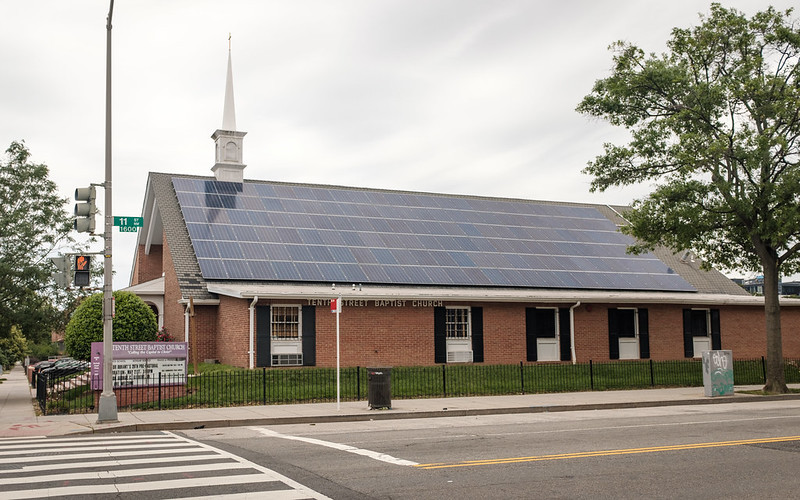Clean Energy in Your Community: Solar Powers America’s Hospitals, Churches, and Rec Centers
Monday, Oct 02 2023

Solar panels at Tenth Street Baptist Church in Washington, D.C. Photo by ep_jhu, licensed under Creative Commons.
In many communities, hospitals, places of worship, and recreation centers play a vital role in bringing people together and helping in times of need.
Now, community centers are turning to solar and storage to provide power and are exploring new solar savings and benefit-sharing models along the way.
Here’s what this looks like across the country.
Solar Powers Places of Worship
Thanks to new federal clean energy incentives, places of worship are adopting solar faster than ever before. Previously, only homeowners and commercial entities could claim the incentives, but under the new law, nonprofits and places of worship can now use them to cut down on the upfront costs of going solar.
Some churches are even sharing their solar savings with the community.
In Washington, DC, Sargent Memorial Presbyterian’s solar array was completed earlier this year with support from local groups, including SunLight General Capital, a woman-owned solar investment firm, and SunCatch Energy, a Black-owned solar installation company. In addition to meeting the church’s energy needs, the system is also providing up to $500 a year in energy savings for 73 households.
Solar is also aiding community service missions for places of worship.
Many churches with solar + storage systems are serving as resilience hubs for community members, so that in the case of power outages and natural disasters, people can go to the church for safety, shelter, and reliable electricity.
Glad Tidings International Church, located near Oakland, CA, broke ground in June on their solar-powered microgrid, aiming to soon provide clean power for their operations while saving over $30,000 a year on energy costs. The savings are going towards building a new community center, that combined with the backup power provided by the solar microgrid’s battery storage, will help the church serve as a resilience center for the community during power outages and other emergencies.
“At the point where we are, there are shortages of water, shortages of energy, the heat… it affects everybody that’s here,” said Bishop Jerry Macklin, pastor of Good Tidings, in a video highlighting his church’s effort to adopt solar energy. “I think now people are beginning to understand that this is everybody’s problem, and everybody has to be a part of the solution.”
Reliable Solar Energy for Healthcare Centers
Hospitals, clinics, and other healthcare centers must have access to constant and resilient energy sources, especially during weather emergencies and natural disasters.
Earlier this year, the Centers for Medicare & Medicaid Services changed federal regulations to allow U.S. hospitals to use clean energy to power their backup generators, paving the way for hospitals to run their operations with clean energy around the clock and during times of emergency.
These new regulations, combined with the reliability and lower costs that clean energy sources provide, are prompting a growing number of hospitals and healthcare centers across America to pursue solar.
Southern Illinois Healthcare is using community solar to power its multi-hospital system in Carbondale, Illinois. By participating in the community solar program with nearby residents, the hospitals are offsetting their energy costs dollar for dollar, saving $119,000 per year on electricity, and improving their overall sustainability.
To defend against blackouts caused by heatwaves, the San Benito Health Foundation in Hollister, CA, installed a solar + storage microgrid to provide nearly all of its energy needs as well as a week’s worth of backup power. About 90% of the clinic’s patients are people of color without health insurance, making San Benito an important lifeline in the community.
“We hope that this will serve as a model for other community health centers,” said Rosa Vivian Fernandez, chief executive of San Benito.
As solar continues to grow, communities of all sizes, in all fifty states, are increasingly realizing the benefits of solar.
Solar supports healthy lives and cleaner air and does so while easing costs and strengthening the grid. Whether it is in schools, homes, places of worship, hospitals, or elsewhere, solar is powering abundant, clean energy in communities across the country.